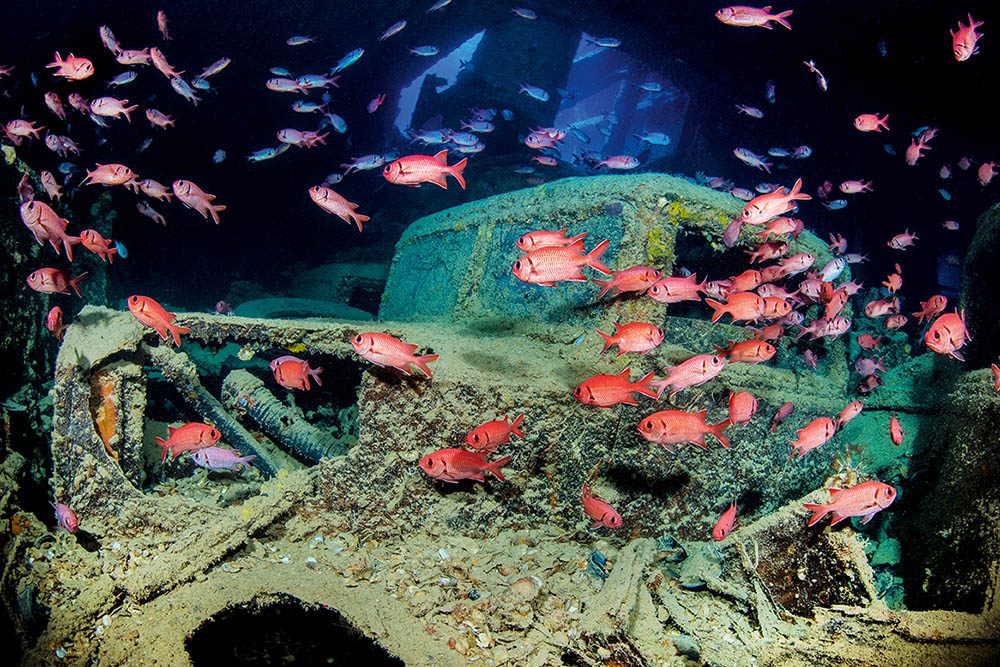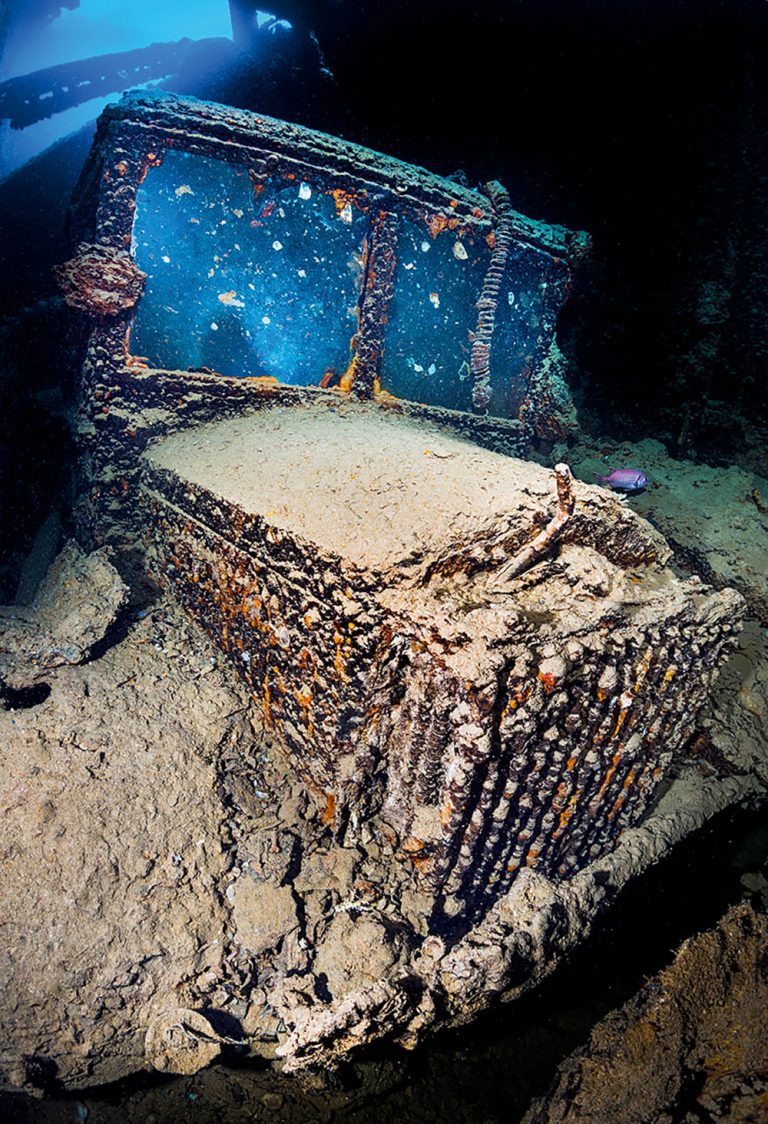With his 2014 DIVER article I-SPY the Thistlegorm, in a Whole New Light, ALEX MUSTARD transformed the way in which divers viewed the iconic WW2 Red Sea wreck.
But how best to photograph that vehicle cargo?
‘The vehicles are what differentiates this wreck, so this is where we should focus our attention and our lenses’
Diving In: Dive 2017 at the NEC
JUST BACK FROM DIVE 2017 at the NEC – a weekend packed with old friends, new gear and enticing travel opportunities. It was also an occasion on which many of us keenly felt the loss of Nigel Wade, although I’m certain that Saeed Rashid’s ribbing tribute was precisely what Nigel would have wanted.
With much to see and so much going on, we all come away with different experiences and favourites from the Show. The best talk I caught was Dr Richard Smith’s How To Capture Reef Life ‘Au Natural’, extolling the virtues and benefits of photographing marine life on its terms.
Richard’s argument was that those photographers who attempt to stage marine-life shots, don’t just risk harming the creatures, but also eradicate any chance of observing fascinating and photogenic natural behaviours, a point that Richard lavishly reinforced with his images.
My main presentation at the Show involved teaming up with Martin Edge to tackle the important subject of ideas and experimentation in underwater photography. I believe that this is more important than ever before, with cameras so capable and photography standards so high.
We ran the audience through our process showing how ideas develop: from early failures, through images that show real promise of something new, and finally to the finished pictures we normally show.
I think people enjoyed this peek at the cutting-room floor and went away prepared to take on more trial and errors, rather than sticking to the tried and trusted.
One of the examples I spoke about was my backlit BSA motorbike from the Thistlegorm, which you will see on these pages next month.
To freshen up Be The Champ! we’re introducing an alternating format: one month it will be the column as you see it here, the next month a more image-led piece and a chance to enjoy underwater imagery printed big across two pages.
The Thistlegorm: A Deep Dive into History
AS HAS BEEN DOCUMENTED before in the pages of DIVER, I have an unhealthy Thistlegorm addiction. In fact the day after the Show, I was in Lincolnshire photographing the only surviving versions of the vehicle on the right.
The truck in question is an Albion AM463. These were used during the war by the RAF as an aircraft-refueller (one of the old fuel hoses is still hanging down across the windscreen in the photo).
Sadly, none of the surviving four are refuellers, but it is still amazing to see this impressive 3m-tall truck in the flesh.
The Thistlegorm is one of my favourite photographic dives, partly because there is so much to shoot and partly because it is a stern photographic challenge.
The vehicles are what differentiates this wreck, so this is where we should focus our attention and lenses.
The challenge is that the vehicles are in the holds, which are dark and filled with silt that is easily disturbed by a careless photographer.
The good news is that if we use the correct approach, we are rewarded with a quality of images that really stand out.
With more than 60 trucks and lorries and over 100 motorbikes in the holds, subject selection is essential.
The size, position and condition of the vehicle are important considerations. However, before that we must get in the right position.
We usually enter the holds through the large openings in the middle of the ship, and from here we see vehicles all around. It’s a mistake to start shooting them.
Instead, we should swim over the vehicles into the darkness of the hold near to the ship’s hull and turn around.
Now we can start searching for vehicles that face in. When we find one that takes our fancy, we discover that rather than shooting into the darkness, we are now shooting into the light. The blue background makes the image feel three-dimensional, and communicates the feeling of being under water.
However, when we are deep inside the holds, the light levels are very low and we usually need to use a long exposure to get this blue to come through.
This is especially true on the early-morning or late-afternoon dives that most liveaboards make on the wreck.
Fortunately, we don’t need to worry about the subject blurring because inside the hold it is darker still, so there is no light to cause blur, and our instantaneous strobes will freeze the detail in the foreground. The longest exposure I have shot on the wreck when using this technique is 8 seconds.

Overcoming the Darkness: Navigating the Holds
THE DARKNESS THROWS UP some other specific challenges, too. First we need to focus the lens, and we don’t want to use a torch because the light will show up in the shot, and cause blur when using long exposures.
Instead we should carefully focus our wide-angle lens before going into the holds and then switch to manual focus so it stays fixed at the correct setting.
Strobe-positioning is also critical when trying to illuminate the vehicles in the dark. When we shoot wide-angle on a reef, if we fail to light part of the scene properly with our strobes it is still there, only blue. In the darkness of the holds, if we fail to light part of the scene, we don’t see it at all – it’s just black.
I typically use rabbit-ears strobe positions inside the wreck, with my strobes lifted up above the housing, making the set-up look a little like Bugs Bunny. This allows the strobes to create a pool of light in front of the camera, giving good coverage and an even exposure from close to the lens to deep into the picture.
When descending, I typically stop on top of the bridge on the way down and set both my focus and strobe positions before heading into the dark confines of the holds.
The final piece of the puzzle is fish. They are important to include in the compositions because they add colour, life and increase the message that the photos are under water. Without them, some Thistlegorm shots can look like a rusting vehicle on land.
The fish are always around, but we need to remember to time our shots for when they are in good positions.
The most common species on the wreck are soldierfish – an appropriate complement for military vehicles.

Diving Deeper: Tips and Techniques
STARTER TIP
Give yourself a few dives to get your bearings on this large and complicated wreck before getting serious about shooting in the holds. And even then, don’t be too greedy and try to photograph everything in one dive.
Much better to focus on a couple of vehicles and shoot them well, rather than race around snapping as much as possible.
MID-WATER TIP
Learn what you are looking at to diversify your portfolio. The best starting place is my article from DIVER October 2014, which lists and describes all the vehicles.
There are 12 different types of vehicle in the two holds, completely different ones on each level and loads of other artefacts.
Also, for each vehicle type there is always one that is in better condition and in a better position than the others.
ADVANCED TIP
The deeper and darker you go into the holds, the better condition the vehicles tend to be in. Also, most vehicles were loaded right up against bulkheads or each other.
This means that you often can’t actually look through the camera to find the best angle, and have to shoot from the hip. Two of the three images in this month’s column were taken in this way.

